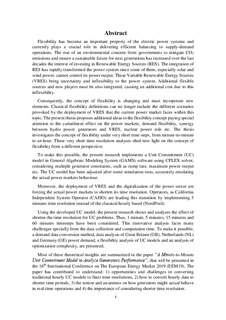| dc.description.abstract | Flexibility has become an important property of the electric power systems and currently plays a crucial role in delivering efficient balancing to supply-demand operations. The rise of an environmental concern from governments to mitigate CO2 emissions and ensure a sustainable future for next generations has increased over the last decades the interest of investing in Renewable Energy Sources (RES). The integration of RES has rapidly transformed the power system since some of them, especially solar and wind power, cannot control its power output. These Variable Renewable Energy Sources (VRES) bring uncertainty and inflexibility to the power system. Additional flexible sources and new players must be also integrated, causing an additional cost due to this inflexibility.
Consequently, the concept of flexibility is changing and must incorporate new elements. Classical flexibility definitions can no longer include the different scenarios provoked by the deployment of VRES that the current power market faces within this topic. The present thesis proposes additional ideas to the flexibility concept paying special attention to the curtailment effect on the power markets, demand flexibility, synergy between hydro power generators and VRES, nuclear power role etc. The thesis investigates the concept of flexibility under very short time steps, from minute-to-minute to an hour. These very short time resolution analyses shed new light on the concept of flexibility from a different perspective.
To make this possible, the present research implements a Unit Commitment (UC) model in General Algebraic Modeling System (GAMS) software using CPLEX solver, considering multiple generator constraints, such as ramp rate, maximum power output etc. The UC model has been adjusted after some simulation tests, accurately emulating the actual power markets behaviour.
Moreover, the deployment of VRES and the digitalization of the power sector are forcing the actual power markets to shorten its time resolution. Operators, as California Independent System Operator (CAISO) are leading this transition by “using” 5 minutes time resolution instead of the classical hourly based (NordPool).
Using the developed UC model, the present research shows and analyses the effect of shorten the time resolution for UC problems. Thus, 1 minute, 5 minutes, 15 minutes and 60 minutes timesteps have been considered. This innovative analysis faces many challenges specially from the data collection and computation time. To make it possible, a demand data conversion method, data analysis of Great Britain (GB), Netherlands (NL) and Germany (GE) power demand, a flexibility analysis of UC models and an analysis of optimization complexity, are presented.
Most of these theoretical insights are summarized in the paper “A Minute-to-Minute Unit Commitment Model to Analyze Generators Performance”, that will be presented in the 16th International Conference on The European Energy Market 2019 (EEM19). The paper has contributed to understand: 1) opportunities and challenges in converting traditional hourly UC models to finer time-resolutions, 2) how to convert hourly data to shorter time periods, 3) the notion and awareness on how generators might actual behave in real-time operations and 4) the importance of considering shorter time resolution.
To conclude, the thesis analyses a case study where the concept of flexibility (based on very short time steps) is analysed and redefined in order to cover a wider spectrum of the concept. Besides, the high synergy between Hydro power and VRES is demonstrated as well as the incompatibility of nuclear power with high share of VRES. For the given portfolio and demand, the curtailment effect sets a limit of VRES share, motivating the development of flexible demands for a green and VRES future. | |
